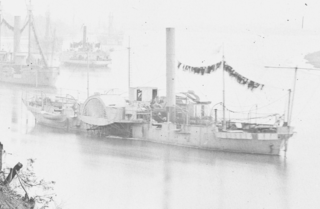USS A. Houghton – a 326 ton bark – was purchased during the beginning of the American Civil War by the Union Navy.

USS Hartford, a sloop-of-war steamer, was the first ship of the United States Navy named for Hartford, the capital of Connecticut. Hartford served in several prominent campaigns in the American Civil War as the flagship of David G. Farragut, most notably the Battle of Mobile Bay in 1864. She survived until 1956, when she sank awaiting restoration at Norfolk, Virginia.

The first USS Miami was a side-wheel steamer, double-ender gunboat in the United States Navy during the American Civil War.

USS Varuna was a screw steamer acquired by the Union Navy during the American Civil War. Under construction in 1861, she was purchased incomplete on 31 December. After being commissioned in February 1862, she traveled to join the West Gulf Blockading Squadron. Varuna was present when Flag Officer David Glasgow Farragut led an attack against Confederate positions at Fort Jackson and Fort St. Philip on 24 April. During the action, Varuna ran ahead of the other Union ships, and was engaged in a chase with the Louisiana gunboat Governor Moore. After closing in on the Union ship, Governor Moore rammed Varuna twice, with the gunboat CSS Stonewall Jackson adding a third blow. Varuna sank within 15 minutes, but Farragut was able to capture the city of New Orleans, Louisiana.
USS Henry Janes was a mortar schooner acquired by the United States Navy during the American Civil War. She was used as a gunboat and assigned to the blockade of ports of the Confederate States of America.

The battle of Forts Jackson and St. Philip was the decisive battle for possession of New Orleans in the American Civil War. The two Confederate forts on the Mississippi River south of the city were attacked by a Union Navy fleet. As long as the forts could keep the Federal forces from moving on the city, it was safe, but if they fell or were bypassed, there were no fall-back positions to impede the Union advance.

USS Owasco was a Unadilla-class gunboat built for the Union Navy during the American Civil War. She was named for Owasco Lake.
USS Horace Beals was a barkentine acquired by the Union Navy during the American Civil War. She was placed into service as a cargo ship assigned to support the fleet blockading the ports of the Confederate States of America. However, at times, Horace Beals was assigned extra tasks, such as that of a hospital ship as well as an ammunition ship.
USS Sarah Bruen was a wooden schooner acquired by the United States Navy during the beginning of the American Civil War.

USS Winona was a Unadilla-class gunboat built for service with the Union Navy during the American Civil War. Winona was heavily armed, with large guns for duels at sea, and 24-pounder howitzers for shore bombardment. Winona saw significant action in the Gulf of Mexico and in the waterways of the Mississippi River and was fortunate to return home safely after the war for decommissioning.

USS Racer was a schooner acquired by the Union Navy during the American Civil War. She was used for various purposes, but, especially for bombardment because of her large 13-inch mortar that could fire up and over tall riverbanks.
USS John Griffith was a mortar schooner acquired by the Union Navy during the American Civil War. She was used for various purposes, but especially for bombardment because of her large 13-inch mortar and 12-pounder howitzers that could fire up and over tall defensive riverbanks.
USS Orvetta was a schooner acquired by the Union Navy during the American Civil War. She was used by the Navy to patrol navigable waterways of the Confederacy to prevent the South from trading with other countries.

USS Maria J. Carlton was a schooner acquired by the United States Navy on October 15, 1861, during the American Civil War. Built before the war, the vessel was converted into a mortar schooner by the Navy. She was then transferred to the mouth of the Mississippi River in early 1862, as part of a force tasked with neutralizing Confederate forts guarding New Orleans, Louisiana. Maria J. Carlton participated in the Battle of Forts Jackson and St. Philip on April 18, but, the battle continuing, was sunk the next day by a shot from Fort Jackson. She was the only Union warship sunk solely by artillery fire from Confederate forts on the Mississippi River during the war.
USS Matthew Vassar was a schooner purchased by the Union Navy during the American Civil War. She was used by the Union Navy primarily as a mortar gunboat, but also as a gunboat stationed off Confederate ports to prevent their trading with foreign countries.
USS Adolph Hugel was a schooner acquired by the Union Navy during the American Civil War.
USS George Mangham was a schooner acquired by the Union Navy during the American Civil War. She was used by the Union Navy as a gunboat in support of the Union Navy blockade of Confederate waterways.
USS Arletta was a schooner acquired by the Union Navy during the American Civil War. She was used by the Union Navy as a gunboat and, at times, an ammunition ship, in support of the Union Navy blockade of Confederate waterways.
USS Norfolk Packet was a large schooner purchased by the Union Navy during the American Civil War. She was assigned to gunboat duty in the inland waterways of the Confederate States of America.
USS T. A. Ward was a 284-ton schooner was purchased by the Union Navy during the Union blockade of the Confederate States of America during the American Civil War.







